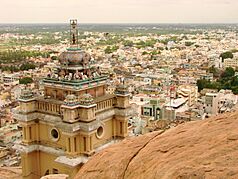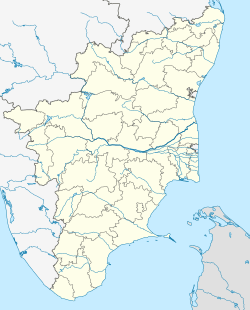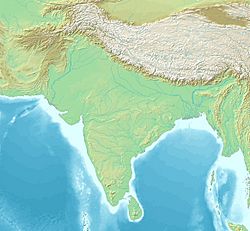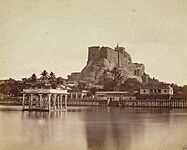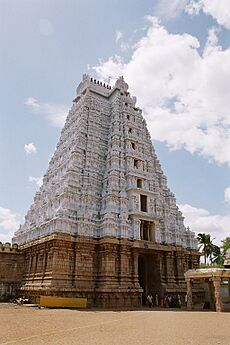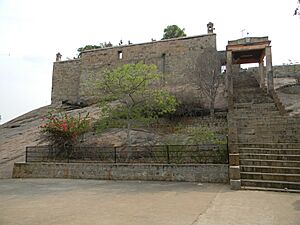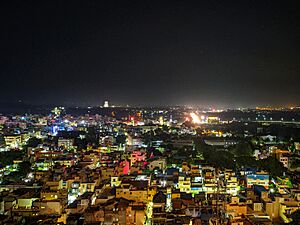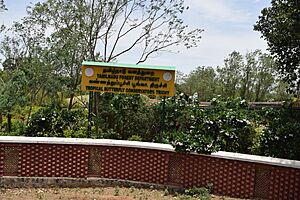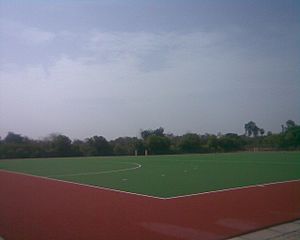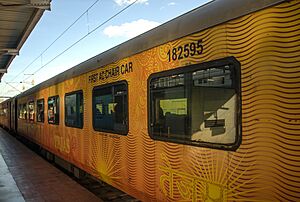Tiruchirappalli facts for kids
Quick facts for kids
Tiruchirappalli
Trichy
|
|
|---|---|
|
Clockwise from top: Ranganathaswamy Temple, Srirangam, Our Lady of Lourdes Church, Jambukeswarar Temple, Thiruvanaikaval, ELCOT IT Park Trichy, Tiruchirappalli Junction, Mukkombu, and Tiruchirapalli Rock Fort.
|
|
| Country | |
| State | |
| District | Tiruchirapalli |
| Zone | Central |
| Government | |
| • Type | Municipal Corporation |
| • Body | Tiruchirappalli City Municipal Corporation |
| Area | |
| • Metropolis | 167.23 km2 (64.57 sq mi) |
| • Metro | 211.51 km2 (81.66 sq mi) |
| Area rank | 4 |
| Elevation | 81 m (266 ft) |
| Population
(2011)
|
|
| • Metropolis | 916,857 |
| • Rank | 52nd 4th in Tamil Nadu |
| • Metro | 1,022,518 |
| • Metro rank | 52nd |
| Demonym(s) | Tiruchiite |
| Languages | |
| • Official | Tamil |
| Time zone | UTC+5:30 (IST) |
| PIN |
620 xxx
|
| Telephone code | 0431 |
| Vehicle registration | TN-45, TN-48, TN-81, TN-81A |
Tiruchirappalli (also called Tiruchi or Trichy) is a big city in the Indian state of Tamil Nadu. It's the main city of the Tiruchirappalli district. People say it's one of the best cities to live in, the cleanest in Tamil Nadu, and the fifth safest for women in India. It's also the fourth largest city in the state.
Tiruchirappalli is located almost in the middle of Tamil Nadu. It's about 322 kilometers south of Chennai and 374 kilometers north of Kanyakumari. The Cauvery Delta starts just 16 kilometers west of the city. Here, the Kaveri River splits into two, forming the island of Srirangam, which is now part of the city. The city covers an area of 167.23 square kilometers and had a population of 916,857 people in 2011.
The city's history goes way back to the 3rd century BC, when the Cholas ruled it. Over time, many different groups ruled Tiruchirappalli, including the Pallavas, Pandyas, and the British. Some of the most famous historical places here are the Rockfort, the Ranganathaswamy Temple (one of the largest temples in the world), and the Jambukeswarar Temple. The ancient town of Uraiyur, which was once the capital of the Early Cholas, is now a part of Tiruchirappalli. The city was very important during the Carnatic Wars (1746–1763) between the British and French trading companies.
Tiruchirappalli is a key education center in Tamil Nadu. It has famous schools and colleges like the National Institute of Technology (NIT) and the Indian Institute of Management (IIM). Many big factories are also located here, such as Bharat Heavy Electricals Limited (BHEL) and the Golden Rock Railway Workshop. Because of all the energy equipment factories, the city is known as the "Energy Equipment and Fabrication Capital of India."
The city was once famous around the world for a type of cigar called the Trichinopoly cigar. It's also a major hub for roads and railways. The Tiruchirappalli International Airport (TRZ) has direct flights to places in the Middle East and Southeast Asia.
Contents
- What's in a Name? Understanding Tiruchirappalli's History
- A Journey Through Time: The History of Tiruchirappalli
- Geography and Climate: Understanding Tiruchirappalli's Environment
- Demographics: Who Lives in Tiruchirappalli?
- Utility Services: How the City Works
- Economy: How Tiruchirappalli Makes Money
- Culture: Life and Traditions in Tiruchirappalli
- Landmarks: Famous Places to See in Tiruchirappalli
- Education: Learning in Tiruchirappalli
- Sports: Playing in Tiruchirappalli
- Media: News and Entertainment in Tiruchirappalli
- Transport: Getting Around Tiruchirappalli
- See also
What's in a Name? Understanding Tiruchirappalli's History
Historically, people in English often called Tiruchirappalli "Trichinopoly." Today, people usually say "Trichy" or "Tiruchi" in everyday talk. The full name, Tiruchirappalli, is mostly used for official things.
Some experts believe the name Tiruchirappalli might come from the word Chiruta-palli, which means "little town." Others think it comes from a 16th-century stone carving that says Tiru-ssila-palli, meaning "holy-rock-town" in Tamil. Another idea is that it comes from Tiru-chinna-palli, meaning "holy little town."
According to old stories, Tiruchirappalli got its name from a three-headed demon named Trishira. He meditated near the city to get blessings from the Hindu god Shiva. Another idea is that the name comes from the Sanskrit word "Trishirapuram," where Trishira means "three-headed" and puram means "city."
A Journey Through Time: The History of Tiruchirappalli
Tiruchirappalli is one of the oldest cities in Tamil Nadu. People have lived here since the ancient Sangam period.
Ancient Times and Early Rulers
Uraiyur, which was the capital of the Early Cholas for 600 years (starting from the 3rd century BC), is now a neighborhood in Tiruchirappalli. The historian Ptolemy mentioned the city as Orthoura in his 2nd-century book Geography. The Kallanai (Lower Anaicut), the world's oldest working dam, was built by Karikala Chola in the 2nd century AD. It's about 18 kilometers from Uraiyur.
The Tiruchirappalli Rock Fort is said to be one of the oldest rock formations in the world. It's an amazing 3.8 billion years old! This makes it older than places like Greenland and the Himalayas.
Medieval Kingdoms and Empires
The medieval history of Tiruchirappalli began with the Pallava king Mahendravarman I in the 6th century AD. He built the rock-cut cave temples inside the Rockfort. After the Pallavas, the Medieval Cholas took over and ruled until the 13th century.
Later, the Pandyas ruled Tiruchirappalli until 1311. Then, Malik Kafur, a commander from the Delhi Sultanate, defeated them. The armies from the Delhi Sultanate are thought to have damaged the area. The statue of the Hindu god Ranganatha in the Srirangam temple disappeared around this time and was only found and put back after more than fifty years.
Tiruchirappalli was ruled by the Delhi and Madurai sultanates from 1311 to 1378. But by the mid-14th century, the Madurai Sultanate started to weaken. The Vijayanagar Empire slowly gained control of the northern parts of the kingdom. In 1371, the Vijayanagar prince Kumara Kampanna Udaiyar took Tiruchirappalli. The Vijayanagar Empire ruled from 1378 until the 1530s. They helped bring back Hinduism by rebuilding temples and monuments that had been destroyed.
After the Vijayanagar Empire fell in the early 16th century, the Madurai Nayak kingdom became independent. The city thrived under Vishwanatha Nayak (around 1529–1564). He is said to have protected the area by building the Teppakulam and walls around the Srirangam temple. His successor, Kumara Krishnappa Nayak, made Tiruchirappalli his capital. It was the capital of the Madurai Nayak kingdom from 1616 to 1634 and again from 1665 to 1736.
In 1736, the last Madurai Nayak ruler, Meenakshi, died. Chanda Sahib then conquered Tiruchirappalli. He ruled from 1736 to 1741 until he was captured by the Marathas. Tiruchirappalli was then managed by the Maratha general Murari Rao from 1741 to 1743. Later, the Nizam of Hyderabad regained control.
During the Second Carnatic War, Muhammed Ali Khan Wallajah fled to Tiruchirappalli and set up his base. The British helped him, and they won against Chanda Sahib and the French. Wallajah became the ruler again. He wanted to rename the city Natharnagar after a Sufi saint. Tiruchirappalli was attacked by Nanjaraja Wodeyar in 1753 and Hyder Ali in 1780, but British forces stopped both attacks. A third attack by Tipu Sultan in 1793 was also unsuccessful.
British Rule and Modern Times
The British took over the Carnatic kingdom in July 1801. This happened after they found out that Tipu Sultan, their enemy, was working with Umdat Ul-Umra, the Nawab at the time. Tiruchirappalli became part of the Madras Presidency that same year. The Trichinopoly District was formed, with Tiruchirappalli as its capital.
During British rule, Tiruchirappalli became one of the most important cities in India. In 1871, it was the second largest city in the presidency after Madras (now Chennai). The city was famous across the British Empire for its special Trichinopoly cigar. Tiruchirappalli was also the first headquarters for the new South Indian Railway Company in 1874.
- Trichinopoly during the British Raj
Tiruchirappalli played an important part in India's fight for independence. There were many strikes and peaceful protests during the Quit India Movement, like the 1928 South Indian Railway Strike. The city was also the starting point for the Vedaranyam march, led by C. Rajagopalachari in 1930.
Tiruchirappalli was a center for protests against the Hindi language. In 1938, Tamil language supporters organized a rally from the city to Madras. In 1965, C. Rajagopalachari held the "Madras state Anti-Hindi Conference" here. After India became independent in 1947, Tiruchirappalli grew a lot. In the 1960s, the city saw a lot of economic growth with the start of Bharat Heavy Electricals Limited.
Geography and Climate: Understanding Tiruchirappalli's Environment
Tiruchirappalli is located in central south-eastern India, almost at the very center of Tamil Nadu. The Cauvery Delta starts about 16 kilometers west of the city. Here, the Kaveri river splits into two streams, the Kaveri and the Kollidam, forming the island of Srirangam.
The city is about 912 kilometers south of Hyderabad, 322 kilometers south-west of Chennai, and 331 kilometers south-east of Bangalore. The land in Tiruchirappalli is mostly flat, with an average height of 81 meters above sea level. There are a few small hills, and the highest is the Rockfort. This rock is estimated to be 3,800 million years old, making it one of the oldest rocks in the world. Other important hills include the Golden Rock and Khajamalai.
Besides the Kaveri and Kollidam rivers, the city also has other water channels like the Uyyakondan Channel. The land near the Kaveri River is very fertile, with rich soil where crops like finger millet and maize are grown. The region is in Seismic Zone III, which means it has a moderate risk of earthquakes.
Urban Structure: How Tiruchirappalli is Built
Tiruchirappalli is on the plains between the Shevaroy Hills to the north and the Palani Hills to the south. The city is surrounded by farms. New industrial and residential areas have been built in the northern and southern parts of the city. The older part of Tiruchirappalli, inside the Rockfort, was not planned out, so it's crowded. But the newer areas next to it are better organized. Many old houses in Srirangam were built following the Shilpa Shastras, which are ancient rules for Hindu temple architecture.
Climate: What's the Weather Like in Tiruchirappalli?
Tiruchirappalli has a dry-summer tropical savanna climate. This means there isn't a big change in temperature between summer and winter. The weather is usually hot and not very humid. With an average yearly temperature of 28.9°C, it's the hottest city in the state.
The hottest months are from April to June, when the city often has dust storms. The highest temperature ever recorded in Tiruchirappalli was 43.9°C on May 2, 1896. The lowest was 13.9°C on February 6, 1884. The high temperatures are partly because of the two rivers, Kaveri and Kollidam, and not enough green spaces around the city. Evenings are cooler because of cold winds from the south-east.
From June to September, the climate is moderate with heavy rain and thunderstorms. The most rain falls between October and December due to the north-east monsoon winds. From December to February, the weather is cool and moist. The average yearly rainfall is 841.9 mm. Fog and dew are rare and only happen in winter.
| Climate data for Tiruchirappalli Airport (1981–2010, extremes 1949–2012) | |||||||||||||
|---|---|---|---|---|---|---|---|---|---|---|---|---|---|
| Month | Jan | Feb | Mar | Apr | May | Jun | Jul | Aug | Sep | Oct | Nov | Dec | Year |
| Record high °C (°F) | 35.6 (96.1) |
40.0 (104.0) |
42.2 (108.0) |
42.8 (109.0) |
43.3 (109.9) |
43.9 (111.0) |
41.1 (106.0) |
40.6 (105.1) |
40.6 (105.1) |
38.9 (102.0) |
36.7 (98.1) |
35.6 (96.1) |
43.9 (111.0) |
| Mean daily maximum °C (°F) | 30.3 (86.5) |
32.8 (91.0) |
35.7 (96.3) |
37.5 (99.5) |
38.2 (100.8) |
37.1 (98.8) |
36.3 (97.3) |
35.8 (96.4) |
35.0 (95.0) |
32.8 (91.0) |
30.4 (86.7) |
29.6 (85.3) |
34.3 (93.7) |
| Mean daily minimum °C (°F) | 20.6 (69.1) |
21.5 (70.7) |
23.5 (74.3) |
26.1 (79.0) |
26.8 (80.2) |
26.6 (79.9) |
26.1 (79.0) |
25.7 (78.3) |
24.9 (76.8) |
24.2 (75.6) |
22.8 (73.0) |
21.2 (70.2) |
24.2 (75.6) |
| Record low °C (°F) | 14.4 (57.9) |
13.9 (57.0) |
15.6 (60.1) |
18.3 (64.9) |
19.4 (66.9) |
18.0 (64.4) |
20.1 (68.2) |
20.6 (69.1) |
20.6 (69.1) |
18.9 (66.0) |
16.7 (62.1) |
14.4 (57.9) |
13.9 (57.0) |
| Average rainfall mm (inches) | 13.3 (0.52) |
3.6 (0.14) |
5.3 (0.21) |
29.6 (1.17) |
67.0 (2.64) |
38.3 (1.51) |
60.5 (2.38) |
69.9 (2.75) |
153.4 (6.04) |
153.9 (6.06) |
168.0 (6.61) |
81.4 (3.20) |
844.2 (33.24) |
| Average rainy days | 0.9 | 0.4 | 0.6 | 1.7 | 3.8 | 2.6 | 2.7 | 4.1 | 7.1 | 9.2 | 8.1 | 5.1 | 46.3 |
| Average relative humidity (%) (at 17:30 IST) | 54 | 43 | 37 | 41 | 42 | 44 | 45 | 46 | 52 | 64 | 70 | 65 | 50 |
| Source: India Meteorological Department | |||||||||||||
In 2024, Tiruchirappalli was ranked the 11th best "National Clean Air City" in India for cities with over 10 lakh (1 million) people.
Demographics: Who Lives in Tiruchirappalli?
In 2011, Tiruchirappalli had a population of 847,387 people. About 9.4% of them were under six years old. The city had 214,529 families. For every 1,000 females, there were 975 males. The Tiruchirappalli urban area had a population of 1,022,518, making it the fourth largest in Tamil Nadu.
The city's literacy rate (how many people can read and write) was 91.37%, which is much higher than India's average of 73.00%. About 26.96% of the people lived in slums. Around 250,000 people visit the city every day.
Most of the people in Tiruchirappalli are Hindu. About twenty percent are Muslims, and there's also a good number of Christians. Smaller groups of Sikhs and Jains live here too.
The main language spoken is Tamil. However, many people also speak Telugu, Gujarati, Kannada, Malayalam, and Hindi. There are also many Anglo-Indians and Sri Lankan Tamil migrants living in the city.
Utility Services: How the City Works
Electricity in Tiruchirappalli is managed by the Tamil Nadu Electricity Board (TNEB). The city gets its drinking water from the Kaveri River and from 1,470 bore wells. These are connected to 60 water storage tanks around the city.
Pollution is a big concern in Tiruchirappalli. The Tamil Nadu Pollution Control Board has five stations to check air quality. In 2012, the city produced about 432 tonnes of solid waste every day. The city corporation handles waste management. Waste water management is done by the Tamil Nadu Water Supply and Drainage Board (TWAD) in some areas and by the Tiruchirappalli Municipal Corporation in others.
In 2009–10, Tiruchirappalli was ranked sixth in India and first in Tamil Nadu for sanitation. In a 2016 survey, it was ranked third among the cleanest cities in India. In 2018, Tiruchirappalli was ranked twelfth in India and first in Tamil Nadu for "ease of living." This ranking looked at things like transport, waste management, and how the city is governed.
Tiruchirappalli is part of the Tiruchi Telecom District, which is run by Bharat Sanchar Nigam Limited (BSNL). BSNL provides phone and internet services. Other major internet providers include Softnet, Tata VSNL, Bharti, and Reliance.
The city has a regional passport office, which helps people get their passports. It serves Tiruchirappalli and seven nearby districts.
Economy: How Tiruchirappalli Makes Money
In the past, during British rule, Tiruchirappalli was known for its leather factories, cigar-making units, and oil presses. At its busiest, over 12 million cigars were made and sent out every year. Leather from Tiruchirappalli was sent to the United Kingdom. Today, the city has many shops and markets, with the Gandhi Market being the most important.
Tiruchirappalli is a major center for making engineering equipment in India. The Golden Rock Railway Workshop, which moved here in 1928, is one of the main railway workshops in Tamil Nadu. It produces many parts for trains.
Bharat Heavy Electricals Limited (BHEL), India's largest public engineering company, set up a factory here in 1965. This factory makes high-pressure boilers. In 2010, the Tiruchirappalli unit of BHEL made almost 30% of the company's total sales. It employs about 10,000 people and is supported by many smaller industries. Together, these companies make about 60% of India's steel parts, earning the city the name "Energy equipment and fabrication capital of India."
Other important industries include Trichy Distilleries and Chemicals Limited (TDCL), which makes various chemicals, and Trichy Steel Rolling Mills. The Ordnance Factories Board also has a weapons factory and a special facility for making heavy projectiles.
Since the late 1980s, a synthetic gem industry has grown in the city. Gemstones are cut and polished here. In the mid-1990s, this industry was making about 100 million Indian rupees a year. There were concerns about children working in this industry. Because of this, Tiruchirappalli district was chosen for the National Child Labour Project to help educate working children.
As of 2010, the Tiruchirappalli region exports about 262.1 million Indian rupees worth of software every year. The ELCOT IT Park Trichy, the city's first IT park, opened in 2010. It cost 600 million Indian rupees and covers an area of 59.74 hectares. This park is a Special Economic Zone. Many companies, including Vuram and iLink Systems, operate from this park. It's also very close to the Tiruchi International Airport.
Culture: Life and Traditions in Tiruchirappalli

Someone from Tiruchirappalli is usually called a Tiruchiite. The culture here is mostly influenced by the traditions of the Kaveri Delta. With many students and workers from different parts of India, Tiruchirappalli has a more diverse feel than the surrounding areas.
The main festival celebrated in Tiruchirappalli is Pongal, a harvest festival in January. Sometimes, as part of Pongal, Jallikattu, a bull-taming sport, is held outside the city. Other important local festivals include Aadi Perukku, the Samayapuram flower festival, Vaikunta Ekadasi, and the Teppakulam float festival. Bakrid and Eid al-Fitr are also widely celebrated because of the large Muslim population. National festivals like Christmas and Deepavali are celebrated too.
The 12th-century Tamil epic Kambaramayanam was first read aloud at the Ranganathaswamy Temple in Srirangam. Many famous Carnatic musicians and scholars come from Tiruchirappalli. Composers and singers who have contributed to Tamil film music, like Vaali, also hail from the city.
Crafts like textile weaving, leather-work, and gem cutting are important in Tiruchirappalli. Wooden statues of Hindu gods and goddesses are sold at Poompuhar, a craft store run by the government. The Trichy Travel Federation (TTF) was started to promote Tiruchirappalli as a good place for tourists. They organize an annual food festival called Suvai.
Landmarks: Famous Places to See in Tiruchirappalli
Tiruchirappalli, once part of the Chola kingdom, has many beautifully carved temples and forts.
Most of the temples, including the Rockfort temples, the Ranganathaswamy Temple at Srirangam, and the Jambukeswarar Temple at Thiruvanaikkaval, are built in the Dravidian style. The Ranganathaswamy Temple and Jambukeswarar Temple are considered excellent examples of this style. The rock-cut cave temples of the Rockfort and the Erumbeeswarar Temple are protected as national monuments.
The Rockfort is a symbol of Tiruchirappalli. It's a fortress on top of a 273-foot-high rock. It has many rock-cut cave temples. The Pallavas first built it, and later the Madurai Nayaks and Vijayanagara rulers rebuilt it. The temple complex has three shrines. Two are for Lord Ganesha, one at the bottom and the Ucchi Pillayar Temple at the top. The Thayumanavar Temple is in between them. The Thayumanavar temple is the largest and has a shrine for Pārvatī.
The Rockfort can be seen from almost anywhere in the northern part of the city. The Teppakulam, a large temple tank at the foot of the Rockfort, is surrounded by markets. It has a small building in its center.
The Ranganathaswamy Temple, dedicated to the Hindu god Vishnu, is on the island of Srirangam. It's often called the largest working Hindu temple in the world. It covers 156 acres and has a perimeter of 4116 meters. The temple is one of the 108 Divya Desams (Holy shrines of Lord Vishnu). It is believed to hold the remains of the saint Ramanujacharya. The Cholas first built it, and later rulers like the Pandyas and Madurai Nayaks renovated it. It has 21 gopurams (towers), and the Rajagopuram is 236 feet tall.
The Jambukeswarar Temple at Thiruvanaikkaval and the Erumbeeswarar Temple at Thiruverumbur were built during the rule of the Medieval Cholas. The Jambukeswarar Temple is one of the Pancha Bhoota Stalams dedicated to Lord Shiva. It is the fifth largest temple complex in Tamil Nadu. The city's most famous mosque is the Nadir Shah Mosque. The Christ Church, built by Christian Friedrich Schwarz in 1766, and the Our Lady of Lourdes Church are good examples of Gothic Revival architecture in the city.
The Chokkanatha Nayak Palace, which now houses the Rani Mangammal Mahal, was built by the Madurai Nayaks in the 17th century. It has been turned into a museum. Other important structures in Tiruchirappalli include the Nawab's palace, the Railway Heritage Centre, the Upper Anaicut, and the world's oldest working dam, the Grand Anaicut.
Education: Learning in Tiruchirappalli
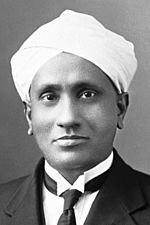
Tiruchirappalli has been known as an important education center since British rule. St. Joseph's College, which moved to Tiruchirappalli in 1883, is one of the oldest schools in South India. The Society for the Propagation of the Gospel (SPG) college, started in 1883, is also a top missionary institution.
As of 2013, Tiruchirappalli had 45 arts and science colleges, 40 polytechnic colleges, and 13 colleges offering management education. The National Institute of Technology, Tiruchirappalli (NIT) is located on an 800-acre campus. It is ranked first among other NITs in India. Other important colleges include National College, Bishop Heber College, and Jamal Mohamed College. There are also about 35 engineering colleges in and around the city.
The Anbil Dharmalingam Agricultural College and Research Institute offers higher education and research in agriculture. The Tiruchirappalli branch of Anna University was created in 2007. The SRM Group of Colleges also established the SRM Institute of Science and Technology near Tiruchirappalli.
The Bharathidasan University was started in Tiruchirappalli in 1982. It oversees 104 colleges in Tiruchirappalli and seven nearby districts. The university also runs a management school. The Indian Institute of Management Tiruchirappalli (IIM) opened in 2011–12. In 2013, the Indian Institute of Information Technology, Srirangam (IIIT) and the Tamil Nadu National Law School also began operations in the city.
There are 200 higher secondary schools in Tiruchirappalli. Some notable ones are St. Johns Vestry Anglo Indian Higher Secondary School and Campion Anglo-Indian Higher Secondary School.
Many famous people were born or studied in Tiruchirappalli. These include C. V. Raman (a Nobel laureate), A. P. J. Abdul Kalam (a former President of India), and the writer Sujatha.
Sports: Playing in Tiruchirappalli
Hockey and cricket are the most popular sports in Tiruchirappalli. Famous Indian hockey players like Charles Cornelius and Leslie Fernandez are from the city. Cricketers like Rajagopal Sathish also come from here.
The Anna Stadium complex is the main place for sports in the city. It has an indoor stadium and a special hockey ground with artificial turf. The stadium also has a football field, a running track, a swimming pool, and a gym. The Tiruchirappalli District Cricket Association (TDCA) manages school, college, and club cricket in the district. First class cricket matches used to be held at the Jawaharlal Nehru Stadium, Tiruchirappalli.
The Mannarpuram Cricket Academy is a well-known cricket coaching center in Tiruchirappalli. The city also hosts local football, tennis, and volleyball tournaments. Tiruchirappalli hosted the Federation Cup, a club football tournament, in 1984. It also held an open chess tournament in 2006.
Media: News and Entertainment in Tiruchirappalli
As of 2013, more than 100 newspapers were registered in Tiruchirappalli. The Wednesday Review, started in 1905, was the first important newspaper published here. Major English newspapers like The Hindu and The New Indian Express have editions in Tiruchirappalli. Many Tamil newspapers also publish local editions, such as Dina Thanthi and Dina Malar.
The first radio station in Tiruchirappalli was opened by All India Radio (AIR) on May 16, 1939. AIR also started a special Carnatic music station called Ragam in 2007. Besides the government-owned AIR, there are private FM radio stations like Hello and Suryan FM. Indira Gandhi National Open University's Gyan Vani started broadcasting from the city in 2008. Holy Cross College started Tiruchirappalli's first campus community radio station in 2006.
Television broadcasting from Chennai began on August 15, 1975. Satellite television channels have been available since 1991.
Transport: Getting Around Tiruchirappalli
The most common ways to travel in Tiruchirappalli are by state government buses (TNSTC) and auto rickshaws. The city has two main bus stations: Chatram Bus Stand and Central Bus Stand. Both offer services to other cities and local transport to nearby areas. New bus stations are being built to improve transport.
Tiruchirappalli is located where two major National Highways meet: NH 45 and NH 67. NH 45 is one of the busiest highways in South India. Another National Highway, NH336, connects Trichy to Pudukkottai and Devakottai. This road is being upgraded to four lanes. State highways like SH 25 also start from the city. Tiruchirappalli has 715.85 kilometers of roads maintained by the city corporation. A semi-ring road is being built to help with traffic jams.
Passenger trains also carry many people from nearby towns. The Great Southern of India Railway Company built its first railway line connecting Tiruchirappalli and Nagapattinam in 1859. The company later merged and made Tiruchirappalli its headquarters until 1908. Tiruchirappalli Junction is one of the busiest railway stations in India. It connects to most important cities and towns across India. Other railway stations in the city include Tiruchirappalli Fort and Srirangam.
Tiruchirappalli is served by Tiruchirappalli International Airport (IATA: TRZ, ICAO: VOTR), which is 5 kilometers from the city center. The airport handles much more international flights than domestic ones. It has regular flights to Chennai, Mumbai, Delhi, Bangalore, Hyderabad, Colombo, Dubai, Kuala Lumpur, and Singapore. In 2013–14, the airport handled over 1 million passengers.
See also
 In Spanish: Tiruchirappalli para niños
In Spanish: Tiruchirappalli para niños


